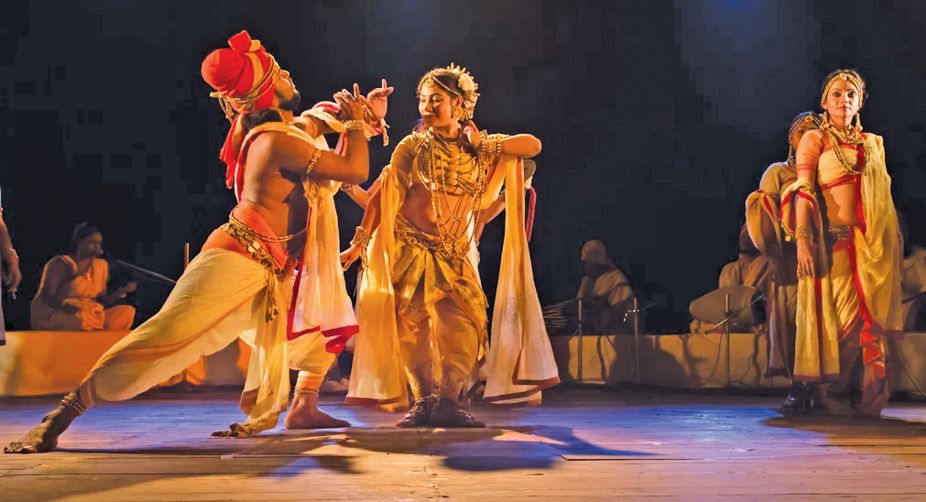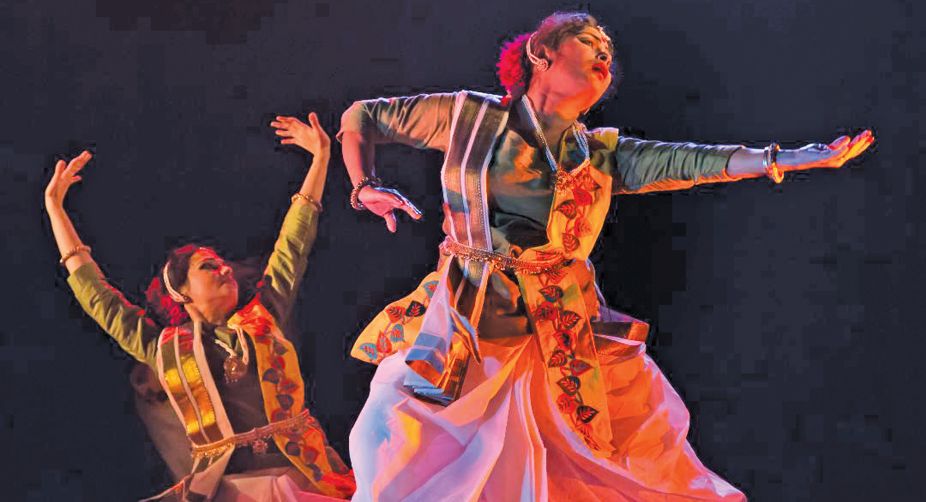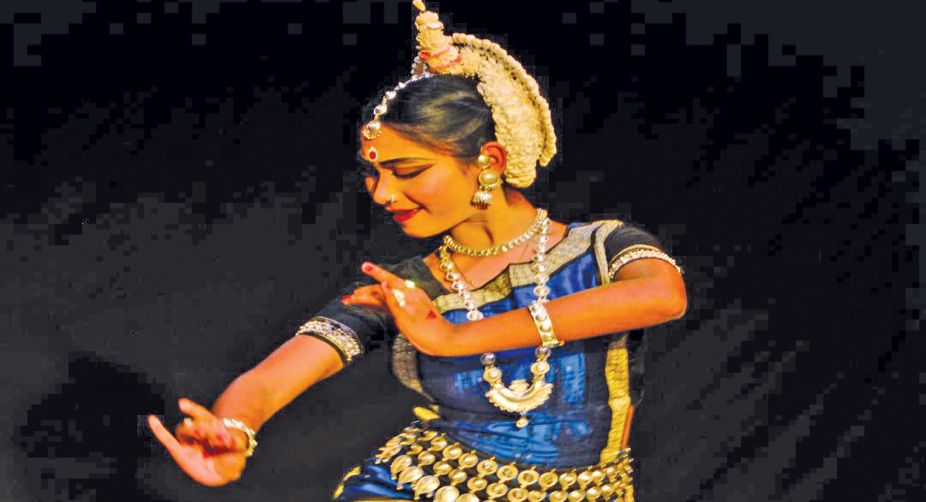Flair for Natyashastra and Bharatanrytam
A beautiful interactive session was held the next morning by Dr Padma Subramaniam on Natyashastra and National Unity with a live demonstration by Gayatri Kannan at the Kolkata Centre for Creativity.
The ancient strains of Indian classical dance was on ample display at a few recent events.
Tapati Chowdhurie | March 24, 2018 2:18 am

Bhanika
Saraswat Sanskriti Kendra, an institution for the propagation, promotion and development of Bharatanatyam, founded in 1984 by Anita Mallick — disciple of Thankamani Kutty — has taken giant strides in fulfilling its goal.
It was a proud moment for Mallick when her production, Biswa Bina Rabe won the Uday Shankar Award in 1997. She has been winning accolades one after the other ever since. Megha Mallar under Swarprakash — an Ode to your Dream — was her recent endeavour performed at Children’s Little Theatre.
Advertisement
It was aimed to be a launching pad for young enthusiasts to display their honed skills in dance. Her students danced to the tune of nature as they performed the piece, Megha Mallar, where monsoon enriches whoever it touches. Monsoon resonates with the sounds of nature and causes ecstasy.
Advertisement

Prakriti or nature was the nayika who made her presence felt when her lover — the monsoon — appeared beating a thousand drums. The conceptualisation of this creative choreography was by Mallick and Kabita Chatterjee, where student participation brought completeness to the piece.
Marga Natya, which followed soon after, is a reconstruction and training system of the performance tradition of Natyashastra, as has been espoused by Bharata Muni.
Researcher Piyal Bhattacharya has been working at the Natyashastra for the last 17 years with the support of the Sangeet Natak Akademi under their scheme of “Safeguarding Intangible Cultural heritage of India”. Recently it has been enlisted under the Guru-Shishya Parampara system of “Training in Marga Natya” under the drama section of SNA, New Delhi.
Bhattacharya, along with his disciples, began with Samaveda Rudram singing, which comes from the ancient way of singing Vedic mantras of Kauthumi Shakha. He also presented Asarita-Vardhamana Vidhi from the Chitra Purvaranga of Natyashastra.
That and a shiva-stuti showed the typical beginning of a Natyashastra performance. It was followed by a short narration by a Sutradhara, which was woven with the singing of Kapaal-geetis.
Bhattacharya also showcased reconstructed ancient musical instruments — a 21-stringed Mattakokila Vina and a triadic-percussion system called Tri-pushkara.
Pinki Mondal, Rinki Mondal, Satabdee Banerjee, Shreetama Banerjee and Manjira Dey were the natis. Sayak Mitra, Manjira Dey and Deep Ghosh were the vocalists. Sayak Mitra was also the Sutradhar. Subhendu Ghosh was on the Mattakokila Vina, while Jay Dalal played the panav and mridang. Bhattacharya was the dardur player.
Yet in an event that followed soon after, held by Deshopriyo Kolkata Cultural Centre, under the direction of Sushmita Banerjee, Bhattacharya collaborated with her and welcomed Puru Dadheech and Vibha Dadheech in a talk on “Kalidasa and Natya Sashtra” at Birla Academy.

There Bhattacharya performed Bhanika, in keeping with Bharata Muni’s performance tradition. Bhanika was by female performers where women characters spoke of wisdom in life and the universe instead of men as is the usual practice.
In Tripitaka, a Buddhist text pre-dating first century BCE, Bhanika was performed by a trained elocutionist, who has heard the teachings of the wise.
Bhanika carried a social message under the veil of delicately decorated costumes and exquisite ornaments. It showed creative energy and spread rasa to manifest Dashavatara.
According to Indian philosophy, avatara is the manifestation of one’s consciousness from the unfathomable depth of unconditioned unconsciousness. This concept was rationalised through Vaishnava and Buddhist world views.
Vajrayana Buddhism professes Dashavatara through the concept of human life and death leading to the attainment of Bodhisattva, the eternal and omnipresent avatara.
Vaishnavism professes the simultaneous manifestation of Hladini, Samvit and Sandhini Shakti through rasa, the unmanifested or Krishna. In the performance Hladini spoke in Brij, Samvit Shakti sang in the Bangla Panchali style to express these illuminating concepts and Hladini Shakti expressed her thoughts through her delicate movements.
The piece was an outcome of the practice received by the trainees and students of Chidakash Kalalay Centre of Art and Divinity, from the Guru-shishya Parampara “Training Programme in Marga Natya”.
The dancers were Sayak Mitra in Rasa’s role playing Kinnari Vina while Samvid Shakti was Manjira Dey, Sandhini Shakti was Rinki Mondal and Hladini Shakti was Pinki Mondal and Pancha Skanda was Moumita Sankhari, Shreetama Chowdhury, Satabdee Banerjee, Dipan Maitra, Amrita Dutta, Akash Mallick, Chhandak Jana, Subhendu Ghosh and Deep Ghosh played the Shrikhol in Kutapa or orchestra.

The vocalist was Sheuli Chakraborty while the Kachchhapi Vina was played by Abhijit Ray. Paramananda Ray played Suhir Vadya, Mithun Chakrabory played Mardangika, Shri Khol was by Joy Dalal and Piyal Bhattacharya.
The speciality of Bhanika lay in the subtle nuances in the costumes and ornamentation. Aharya abhinaya and Amantran-patra were designed by Chhandak Jana. Natyacharya Piyal Bhattacharya and Gitacharya Sayak Mitra were excellent. The light designing was by Soumen Chakraborty.
Kalidasa’s Kumarsambhavam was performed by Sushmita Banerjee and her disciples. As the name suggests the story was about the birth of Kartikeya, who as predicted by Brahma, would be instrumental in killing the demon Taraka who was troubling the gods.
There are several stories interwoven in Kumarasambhava and therefore it is a dancers’ delight. Parvati must marry Shiva and give birth to Kartikeya to bring peace and save the Gods. There was drama at every point and a Kathaka moulded the events to her advantage in the Kathak genre to bring about aesthetic delight.
Banerjee passed all the tests of a stor-teller. Parvati had to undergo severe penance to win Shiva. The audience was shown Shiva coming to Parvati in disguise only to test Parvati’s steadfastness in her love.
Kartikeya’s birth and the annihilation of Taraka was a classical piece of work in the rendition of which Banerjee was flawless. She was Parvati while Disha was Shiva. Together they made quite a pair. Odissi dancers Arundhati Roy and Rajib Bhattacharya eat and breathe Odissi.
The recently held festival Parampara 2018 bears testimony to it. Young dancers were given a platform to prove their mettle. Mentors and gurus came together to present their best students at this forum.
Anushka Rahman, disciple of Dona Ganguly, Kamalika Bose, disciple of Rajib Bhattacharya, Ashmeeta Bagchi, Prashnika Dutta, disciple of Shib Narayan Banerjee, Rahul Roy, mentored by Pompi Paul, among others made a mark.
Most of their pieces were choreographed by great names like Kelucharan Mohapatra, Sanjukta Panigrahi and Ratikant Mohapatra.

It was only Kakali Bose who dared to make her student Asheemita Bagchi to dance Desh Pallavi composed by her. But the one who outshone all others was Preetisha Mohapatra, who is a chip off the old block.
She bowled over the audience with Mangaldhwani Pallavi and the abhinaya piece, Se Shyama Chhabi Chhataka, both composed by her father and mentor Ratikant Mohapatra.
Advertisement
A beautiful interactive session was held the next morning by Dr Padma Subramaniam on Natyashastra and National Unity with a live demonstration by Gayatri Kannan at the Kolkata Centre for Creativity.
He had served as Professor and Head of the Dance Department at Bhatkhande University, Lucknow, and as Dean, Faculty of Arts, at Indira Kala Sangeet Vishwa Vidyalaya, Khairagarh, teaching and guiding several research scholars for their doctoral thesis.
William Shakespeare's works were Indianised in the early 20th century Bengali stage by incorporating elements from Indian myths and the Natyashastra
Advertisement
